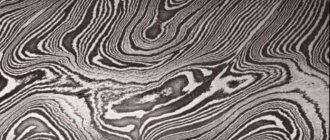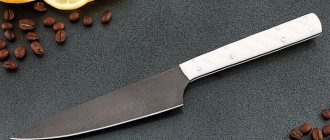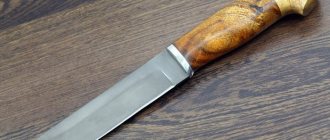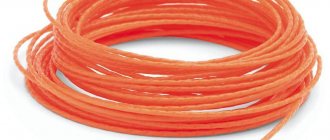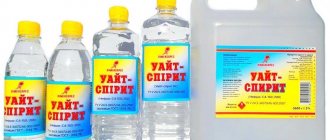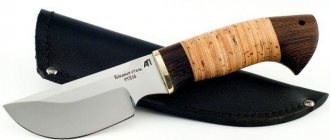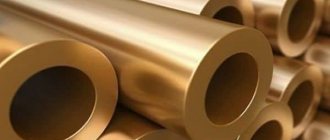Characteristics
9XC steel contains many alloying additives that provide the desired characteristics and properties. In addition to the main components, there are silicon, calcium, chromium, carbon, sulfur, in total 12 alloying and additional components. Thanks to this complex of substances, steel has the following main characteristics:
- density (r) – 7830 kg/m3;
- Rockwell hardness (HRC) depends on the tempering temperature - from 63-64 to 39-48 ∂;
- HB 10-1 = 241 MPa;
- forging temperature indicators: from 1180 to 800 degrees.
Due to its increased elasticity, pronounced strength, wear resistance and density, steel of this type is considered the best option for creating cutting tools and components of this type.
Explanation of markings
Each type of steel has its own marking, which encodes the characteristics of the composition. The marking of 9ХС steel has the following meaning:
- the number “9” shows that the alloy contains 0.9% carbon;
- the letter “x” indicates the presence of chromium in the steel;
- the letter “c” indicates that silicon has been added to the composition.
The presence of carbon provides increased viscosity of the substance. Chromium is a universal component; it increases the thermal impact capabilities of the alloy, makes it as durable as possible and eliminates the risk of corrosion.
pros
9ХС steel has advantages that set it apart from other alloys.
- It has unique technical characteristics that allow it to be used in the manufacture of strong, elastic, wear-resistant parts with a high bending resistance coefficient.
- In alloy 9ХС, carbides are always evenly and correctly distributed over the cross-section, which improves the performance qualities of the finished product, in particular, threaded elements created from it.
- It has a high degree of resistance to mechanical damage and cracking.
- After annealing, it acquires another undeniable advantage - increased hardness and ductility to calcination.
- Has high thermal stability.
- The alloy is resistant to flocking during finishing.
Thanks to these advantages, 9ХС steel is a popular and practical tool alloy.
Minuses
There are also disadvantages to this alloy, which also need to be taken into account in the production of tools and cutting products.
- Specific requirements for heat treatment.
- Not suitable for welding work.
- When processing, strict adherence to temperature conditions is required.
- Complicated mechanical processing.
Only highly qualified specialists need to work with 9XC alloy, as there are conditions and nuances that must be met.
Blade made of 9ХС steel.
Alloy Use
The use of 9ХС occurs in the following cases:
- Making drills. But they can only be used for drilling holes on soft objects, mainly wood. Since the tool reacts negatively to high rotation speeds and overheating, it is recommended to adjust the speed when working with a soft structure.
- Cylindrical reamers. They are used to improve the accuracy of hole sizes and remove roughness. The device can be used to process vents in cast iron, alloys with medium hardness, and when working with non-ferrous iron.
- Taps. They are necessary for cutting internal threads, and are presented in the form of a screw with straight or helical grooves. When working, it is recommended to protect the product from intense loads.
- Stamps for cold work. Their use is common in factories for stamping finished products.
All actions with this material must be carried out strictly according to the rules. Otherwise, the product will lose all its positive qualities.
Chemical composition
To create 9ХС steel, 13 substances are used, the combination of which in the right quantities results in qualitatively better physical, mechanical and operational characteristics.
Here are the components that make up 9ХС steel:
- iron (Fe) – 94%;
- silicon (Si) – up to 1.6%, but not less than 0.9%;
- chromium (Cr) – up to 1.25%, but not less than 0.95%;
- carbon (C) – 0.9%;
- manganese (Mn) – up to 0.6%;
- nickel (Ni) – 0.35%;
- copper (Cu) – 0.3%;
- molybdenum (Mo) – 0.2%;
- tungsten (W) – 0.2%;
- vanadium (V) – 0.15%;
- sulfur (S) – 0.03%
- phosphorus (P) – 0.03%;
- titanium (Ti) – less than 0.03%.
Percentages may vary slightly among different manufacturers. Deviations should not exceed 1/10 of a percent, otherwise the properties of the resulting alloy may differ.
Advantages and disadvantages
Metal 9ХС has a number of advantages.
- Unique technical characteristics. This metal is considered quite durable. It produces wear-resistant products that are practically not subject to mechanical stress; they are very resistant to bending and torsion. Even with constant use, they will not become deformed. In addition, cracks and other small defects practically do not form on their surface.
- Increased hardness. It is achieved after annealing. Also, after this procedure, the material becomes absolutely susceptible to calcination.
- Corrosion protection. This steel contains chromium, which protects the material from the negative effects of water.
- Hardness. Tools made from such steel can easily cut other metals and dense wood.
- Same carbide distribution. This provides advantages when using this metal in the manufacture of thread-cutting devices that have a fine thread pitch.
In addition, it can be noted that the metal is characterized by increased hardenability and elasticity. It can hold an edge for a long time.
But 9ХС grade steel also has some disadvantages.
- Appearance. This metal will not shine; a peculiar pattern can be seen on its surface.
- Relatively high cost. Products made from this metal are produced by hand forging, which is why their price is quite high.
- Difficulty of processing. Even small errors in the manufacture of such steel can lead to a decrease in its quality. It behaves rather capriciously during heat treatment and sharpening.
- Loses its properties at elevated temperatures. When heated above 200 degrees, the cutting qualities of the tools are primarily reduced. It should also be noted that this variety is not suitable for the production of welded structures. During heat treatment, the material will require compliance with a specific optimal temperature regime.
- Care requirements. Chrome and silicon will not fully protect steel, so you will need to carefully wipe and dry tools after contact with water. Otherwise, over time it will begin to rust.
Application
Widely used in industry, it is used to create such products:
- knives;
- knife blades and other cutting tools;
- drills of different diameters and purposes;
- cutters for industrial and household equipment;
- stamps that are used in cold-type work;
- parts for equipment.
Steel can be used in other areas if the technical and operational characteristics meet the requirements for the products being manufactured.
Knife “Mushroom picker” - hand forged, steel 9ХС, walnut.
Price
9ХС is an expensive type of steel. This is due to the peculiarities of its production. Such blades are not stamped. They require hand forging. This significantly increases the cost of the product, but on the other hand, exclusivity attracts buyers. The average price for a knife made of this steel grade ranges from 6,000 to 25,000 rubles.
A knife made of 9XC steel is reliable, has a huge margin of safety and excellent cutting qualities. With proper care, it will last for many years and will not break or corrode.
Reviews of knives from 9ХС
For the needs of the food industry, hunting, tourism and other activities, knives made from 9ХС steel are often used. Impressions of use are mostly positive. Users note difficulties in sharpening and the possibility of nicks. In general, owners of 9XC knives are satisfied and note the high strength of the products, long-term retention of the original sharpness after sharpening.
9ХС is a specialized alloy used for durable cutting tools, threaded components, and abrasion-resistant parts. If the technical requirements for processing are met, this metal alloy is quite good in operation.
Previous
KnivesSteel RWL-34 from Damasteel
Next
KnivesSteel CPM S35VN
Analogs
Foreign analogues are:
- DIN
- WNr
- 150Cr14
- 90CrSi
- 90CrSi5
Blades made from this steel have proven themselves well in fishing, hunting and mushroom picking. They can be used during tourist excursions. Unlike more popular brands, knives made from 9xc by forging are more reliable and withstand aggressive environmental conditions well.
Tool steels are widely used today. They are highly durable. Thanks to which they have a wide range of applications. Modern industry makes it possible to produce tool steel of several grades. The material described in this article has all the necessary properties for making knives. Their characteristics are several times superior to knives made of bearing steel.
Advantages
- The advantages of the material include outstanding technical characteristics . For this reason, it is generally a suitable choice for the production of parts or individual elements that must have properties such as wear resistance, elasticity and bending resistance.
- When it is necessary to make cutting-type elements or any components, experts in this matter mainly choose the 9xc brand. The choice in favor of this particular brand is due to a number of aspects. In the case under consideration, one can note the uniform distribution of carbides over the cross section. Thanks to this feature, a significant advantage is provided when using this material in the manufacture of thread-cutting tools with a fine thread pitch.
- Billets made on the basis of this steel, used in the manufacture of certain products, are characterized by a high level of resistance to cracking.
- In addition to this, another property deserves special mention - a high level of hardness in the annealed state . This material can be easily calcined and at the same time demonstrates excellent resistance to heat. All these advantages also apply to knives made on the basis of 9xc.
Hardness of steel 9ХС depending on tempering temperature
| Temperature, °C | HRC∂ |
| Quenching 840-860°C, oil | |
| 170-200 200-300 300-400 400-500 500-600 | 63-64 59-63 53-59 48-53 39-48 |
| Heat resistance of steel 9ХС | ||
| Temperature °C | Time, h | HRC∂ |
| 150-160 240-250 | 1 1 | 63 59 |
Peculiarities
This tool steel contains many alloying additives . One of them is chromium , the content of which in the alloy ranges from 0.95-1.25%. Thanks to chromium, a higher level of hardness is achieved, strength and corrosion resistance are increased. Silicon, which is also present in the composition of this steel, demonstrates similar qualities, and its amount in the alloy exceeds 1%.
The properties of silicon help to increase the strength threshold, while the level of ductility and toughness decreases slightly. At the same time, the fluidity of the material and cold brittleness increases.
In addition to the above-mentioned properties, one can note the traction of the material to the tempering ability of processing by cutting the workpiece in a hot state. Interestingly, this tool steel does not have such a drawback as a tendency to be damaged by flakes - defects in the internal structure that negatively affect the strength characteristics.
When choosing knives based on the steel in question, you need to be aware of one important nuance - 9xc is not very suitable for the production of welding-type structures. It is recommended to use such workpieces exclusively in the case of resistance spot welding. Products based on this brand should only be used on cold surfaces.
The procedure for heat treatment of the steel in question for knives is carried out using electric furnaces with a sealed casing, equipped with automated control of the heating temperature and atmosphere. At the same time, during the heat treatment process, it is still necessary to regularly monitor the temperature and constantly check the hardness.
In addition, structural metallographic control and X-ray analysis for the presence of defects in the structure are required.
Mechanical properties of 9ХС steel at elevated temperatures
| Test temperature, °C | σ0.2 (MPa) | σв (MPa) | δ5 (%) | ψ % | KCU (kJ/m2) | NV |
| Delivery status | ||||||
| 20 | 445 | 790 | 26 | 54 | 39 | 243 |
| 200 | 320 | 710 | 22 | 48 | 88 | 218 |
| 400 | 330 | 620 | 32 | 63 | 98 | 213 |
| 600 | 170 | 200 | 52 | 77 | — | 172 |
| 700 | 83 | 98 | 58 | 77 | 147 | — |
| Sample 10 mm in diameter, 50 mm long, rolled. Deformation speed 20 mm/min. Strain rate 0.007 1/s | ||||||
| 800 | 110 | 130 | 26 | 68 | — | — |
| 900 | 65 | 74 | 41 | 95 | — | — |
| 1000 | 42 | 46 | 52 | — | — | — |
| 1100 | 20 | 31 | 54 | — | — | — |
| 1200 | 15 | 20 | 83 | 100 | — | — |
Flaws
In addition to a number of significant advantages, steel also has some disadvantages. As an example, during heat treatment the material behaves quite capriciously; compliance with a specific temperature regime is required.
Another fly in the ointment is that the chemical composition of different batches can vary significantly. Given the complexity of mechanical processing, to obtain the desired result you will need to attract a highly qualified craftsman. However, even under the supervision of specialists, not every product is able to withstand final inspection.

